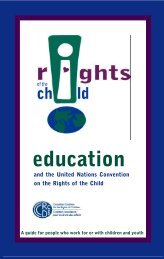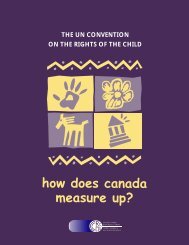CCRC report on rights of children in Canada - Canadian Coalition ...
CCRC report on rights of children in Canada - Canadian Coalition ...
CCRC report on rights of children in Canada - Canadian Coalition ...
You also want an ePaper? Increase the reach of your titles
YUMPU automatically turns print PDFs into web optimized ePapers that Google loves.
“My parents were immigrants and <strong>on</strong>e <strong>of</strong> their struggles was try<strong>in</strong>g to get a job while hav<strong>in</strong>g some<strong>on</strong>e to<br />
look after my brother and me. They didn’t have m<strong>on</strong>ey to put us <strong>in</strong> a daycare and sometimes they had to<br />
leave us home al<strong>on</strong>e and that causes safety issues. A free daycare for refugees and immigrants would be<br />
good.”<br />
<str<strong>on</strong>g>CCRC</str<strong>on</strong>g> Youth C<strong>on</strong>sultati<strong>on</strong>, August 24th, 2011<br />
Access to Services<br />
Children who arrive <strong>in</strong> <strong>Canada</strong> as landed immigrants may not immediately qualify for health care<br />
coverage <strong>in</strong> some prov<strong>in</strong>ces, <strong>in</strong>clud<strong>in</strong>g the largest prov<strong>in</strong>ce <strong>of</strong> Ontario, where they are subject to<br />
a three m<strong>on</strong>th wait<strong>in</strong>g period. Families whose <strong>children</strong> become ill dur<strong>in</strong>g this period either seek<br />
healthcare at great f<strong>in</strong>ancial cost to the families, <strong>of</strong>ten putt<strong>in</strong>g them <strong>in</strong> debt for decades, or avoid<br />
seek<strong>in</strong>g treatment altogether, which <strong>of</strong>ten results <strong>in</strong> more serious health c<strong>on</strong>sequences.<br />
All <strong>children</strong> who arrive <strong>in</strong> <strong>Canada</strong> as landed immigrants should receive immediate coverage for health<br />
care.<br />
F<strong>in</strong>ally, <strong>children</strong> <strong>in</strong> all prov<strong>in</strong>ces/territories have a legal right to attend school even if they or their parents<br />
do not have immigrati<strong>on</strong> status <strong>in</strong> <strong>Canada</strong>. In practice, however, some parents experience obstacles<br />
to the enrolment <strong>of</strong> their <strong>children</strong>, fear <strong>of</strong> repercussi<strong>on</strong>s if they identify themselves to a local school,<br />
and lack <strong>of</strong> <strong>in</strong>formati<strong>on</strong> about the right to attend school. There are examples <strong>of</strong> <strong>children</strong> be<strong>in</strong>g denied<br />
enrolment. 86 Tra<strong>in</strong><strong>in</strong>g <strong>of</strong> school <strong>of</strong>ficials, appropriate protocols for enrolment, and public awareness can<br />
help to ensure <strong>children</strong> are not denied an educati<strong>on</strong> because <strong>of</strong> the citizenship status <strong>of</strong> their parents.<br />
Recommendati<strong>on</strong>s<br />
ACTION<br />
Apply the ‘best <strong>in</strong>terest <strong>of</strong> the child’ pr<strong>in</strong>ciple <strong>in</strong> all<br />
decisi<strong>on</strong>s affect<strong>in</strong>g <strong>children</strong> under the Citizenship and<br />
Immigrati<strong>on</strong> Act. Follow established guidel<strong>in</strong>es, such<br />
as the UNHCR Guidel<strong>in</strong>es for Determ<strong>in</strong>ati<strong>on</strong> <strong>of</strong> the Best<br />
Interest <strong>of</strong> Children, with clear criteria for evaluati<strong>on</strong> and<br />
follow-up acti<strong>on</strong>, to achieve c<strong>on</strong>sistent applicati<strong>on</strong>.<br />
Tra<strong>in</strong> all immigrati<strong>on</strong> <strong>of</strong>ficials who may come <strong>in</strong>to<br />
c<strong>on</strong>tact with <strong>children</strong> <strong>in</strong> the use <strong>of</strong> the guidel<strong>in</strong>es. Deal<br />
with cases <strong>in</strong>volv<strong>in</strong>g <strong>children</strong> without delay.<br />
Establish an automatic review process when <strong>children</strong> are<br />
deta<strong>in</strong>ed to help ensure that detenti<strong>on</strong> is <strong>on</strong>ly used <strong>in</strong><br />
excepti<strong>on</strong>al circumstances <strong>in</strong> their best <strong>in</strong>terests, when<br />
there is no other alternative.<br />
Develop and implement a nati<strong>on</strong>al strategy for separated<br />
<strong>children</strong>, as recommended <strong>in</strong> the sec<strong>on</strong>d review.<br />
Actors (Lead and Ma<strong>in</strong> Actors)<br />
Citizenship and Immigrati<strong>on</strong> <strong>Canada</strong><br />
Public Safety <strong>Canada</strong><br />
Citizenship and Immigrati<strong>on</strong> <strong>Canada</strong><br />
Public Safety <strong>Canada</strong><br />
Citizenship and Immigrati<strong>on</strong> <strong>Canada</strong><br />
ACTION<br />
Ensure access to educati<strong>on</strong>, health, and social<br />
services for all <strong>children</strong>, regardless <strong>of</strong> the status<br />
<strong>of</strong> their parents. Tra<strong>in</strong> health care, social service<br />
providers, and school adm<strong>in</strong>istrators <strong>on</strong> their legal<br />
obligati<strong>on</strong>s.<br />
Amend the Citizenship Act to prevent the creati<strong>on</strong> <strong>of</strong><br />
stateless <strong>children</strong>.<br />
Actors (Lead and Ma<strong>in</strong> Actors)<br />
Citizenship and Immigrati<strong>on</strong> <strong>Canada</strong><br />
Human Resources and Skills Development<br />
<strong>Canada</strong><br />
Prov<strong>in</strong>cial/territorial departments <strong>of</strong> social<br />
services<br />
Citizenship and Immigrati<strong>on</strong> <strong>Canada</strong><br />
d REALIZING THE RIGHTS OF CHILDREN<br />
WITH DISABILITIES<br />
Introducti<strong>on</strong><br />
The <strong>rights</strong> <strong>of</strong> <strong>children</strong> with disabilities are explicitly recognized <strong>in</strong> the C<strong>on</strong>venti<strong>on</strong> <strong>on</strong> the Rights <strong>of</strong> the<br />
Child provides both universal protecti<strong>on</strong> <strong>of</strong> the <strong>rights</strong> <strong>of</strong> <strong>children</strong> with disabilities and special recogniti<strong>on</strong><br />
(article 23) <strong>of</strong> the needs <strong>of</strong> <strong>children</strong> with disabilities <strong>in</strong> realiz<strong>in</strong>g those universal <strong>rights</strong>. Despite progress<br />
<strong>in</strong> <strong>Canada</strong> – <strong>in</strong> legislati<strong>on</strong>, theory and practice – the <strong>rights</strong> <strong>of</strong> <strong>children</strong> with disabilities are still not be<strong>in</strong>g<br />
fully realized.<br />
This summary provides a snapshot <strong>of</strong> the situati<strong>on</strong> <strong>of</strong> <strong>children</strong> with disabilities <strong>in</strong> <strong>Canada</strong>, and highlights<br />
recommendati<strong>on</strong>s from a more detailed work<strong>in</strong>g paper .87 Acti<strong>on</strong> <strong>on</strong> these matters is important because<br />
patterns <strong>of</strong> exclusi<strong>on</strong> or <strong>in</strong>clusi<strong>on</strong> beg<strong>in</strong> <strong>in</strong> childhood.<br />
Children with Disabilities <strong>in</strong> <strong>Canada</strong><br />
• There are 202,350 <strong>children</strong> with disabilities under the age <strong>of</strong> 15 – <strong>of</strong> these, about 57% have mild to<br />
moderate disabilities and 43% have severe or very severe disabilities.<br />
• Children with disabilities are twice as likely as other <strong>children</strong> to live <strong>in</strong> households that rely <strong>on</strong> social<br />
assistance as a ma<strong>in</strong> source <strong>of</strong> <strong>in</strong>come.<br />
• 19.1% <strong>of</strong> <strong>children</strong> with disabilities live <strong>in</strong> households that fall below the Low Income Cut Off,<br />
compared to 13.4% <strong>of</strong> <strong>children</strong> without disabilities.<br />
“Schools are do<strong>in</strong>g a good job at recogniz<strong>in</strong>g and adapt<strong>in</strong>g to their needs, physically more than mentally.<br />
Students are start<strong>in</strong>g to take acti<strong>on</strong> like the Best Buddies program and events <strong>in</strong> schools where students<br />
<strong>in</strong>teract with students with disabilities. Some schools still d<strong>on</strong>’t have any <strong>in</strong>itiatives and any disabled<br />
<strong>children</strong> are kept <strong>in</strong> a separate secti<strong>on</strong> <strong>of</strong> the school.”<br />
<str<strong>on</strong>g>CCRC</str<strong>on</strong>g> Youth C<strong>on</strong>sultati<strong>on</strong>, August 24th, 2011<br />
74 Right <strong>in</strong> pr<strong>in</strong>ciple, right <strong>in</strong> practice Pay<strong>in</strong>g Attenti<strong>on</strong> to Vulnerable Children 75




